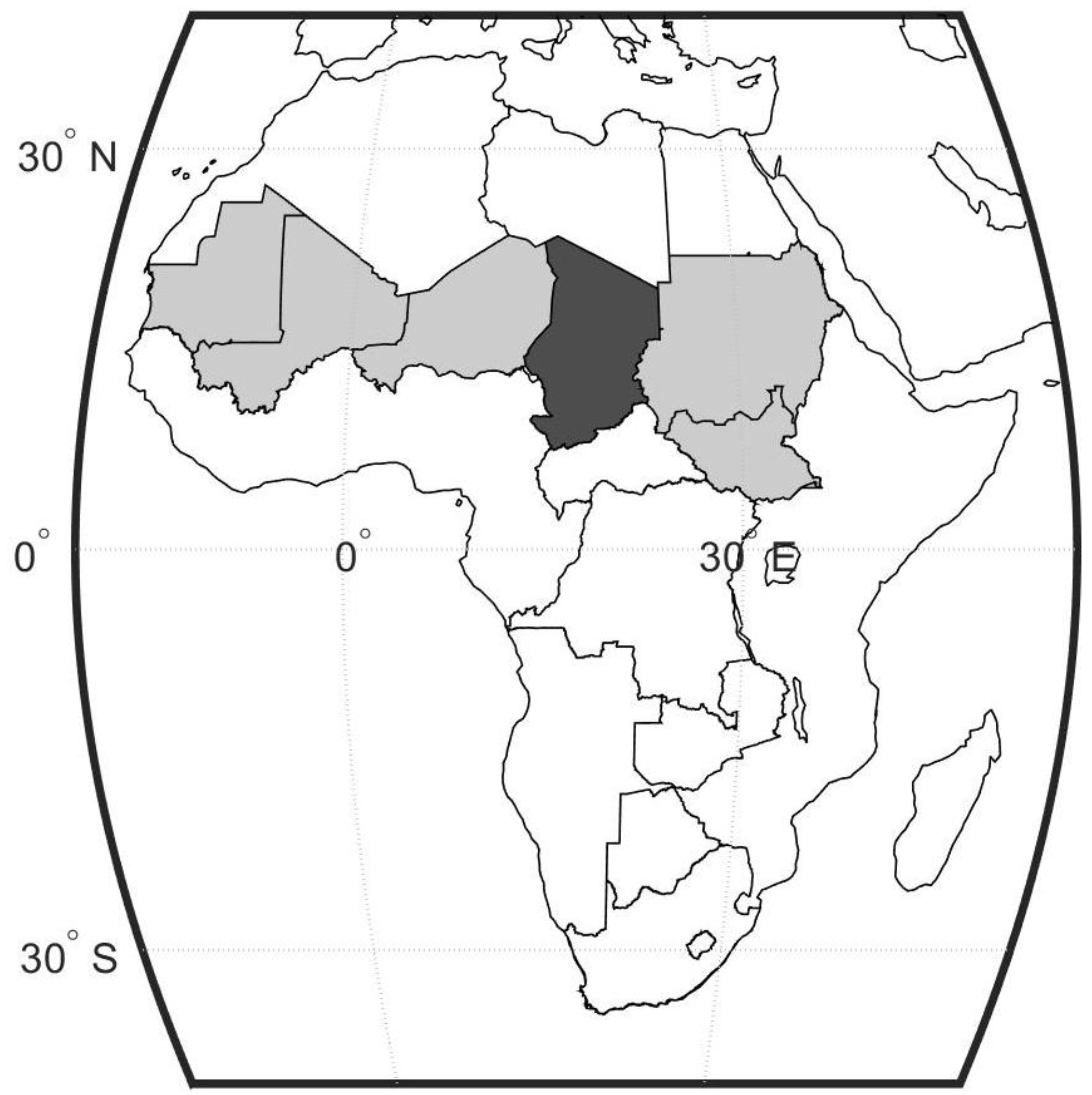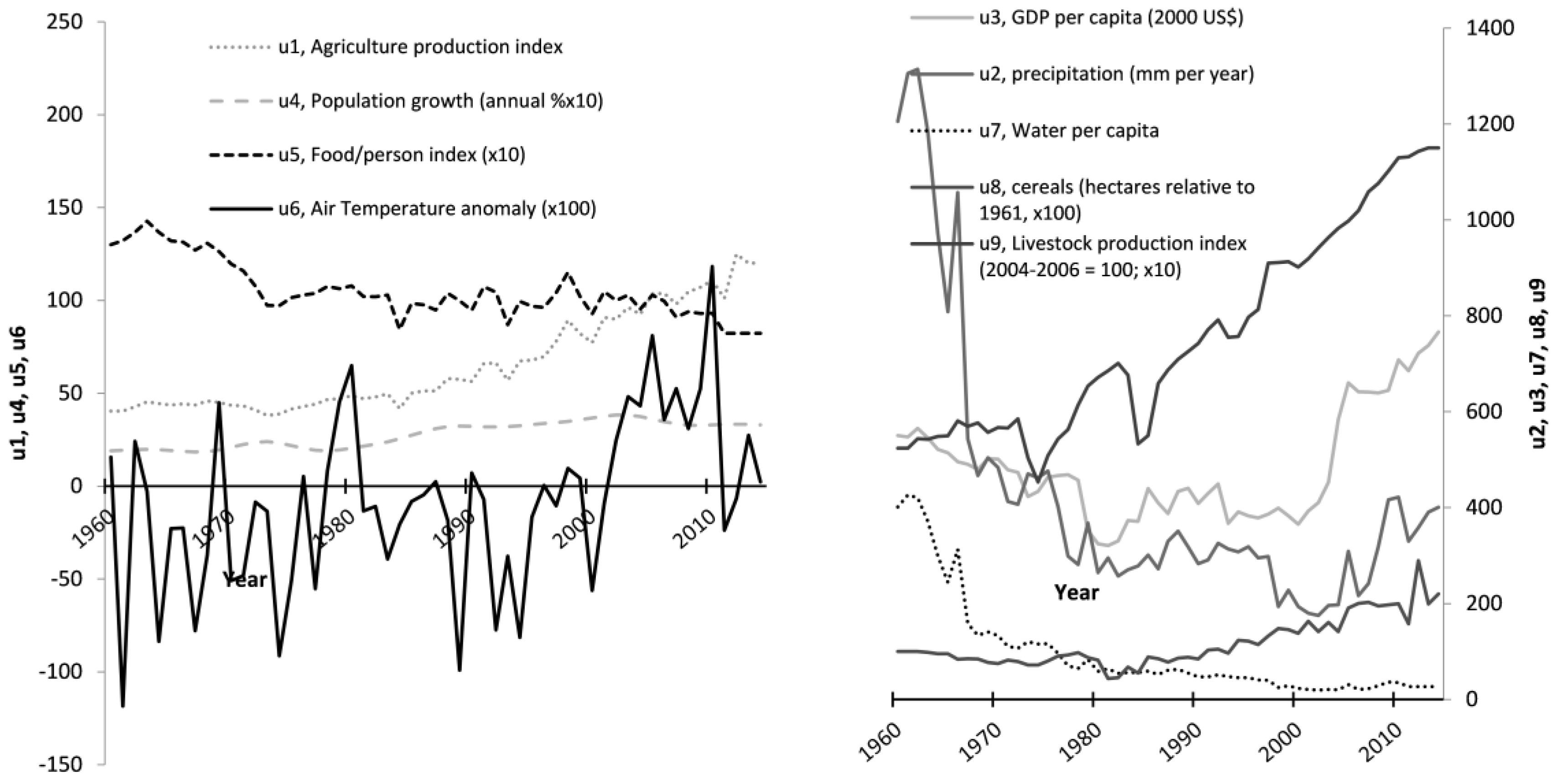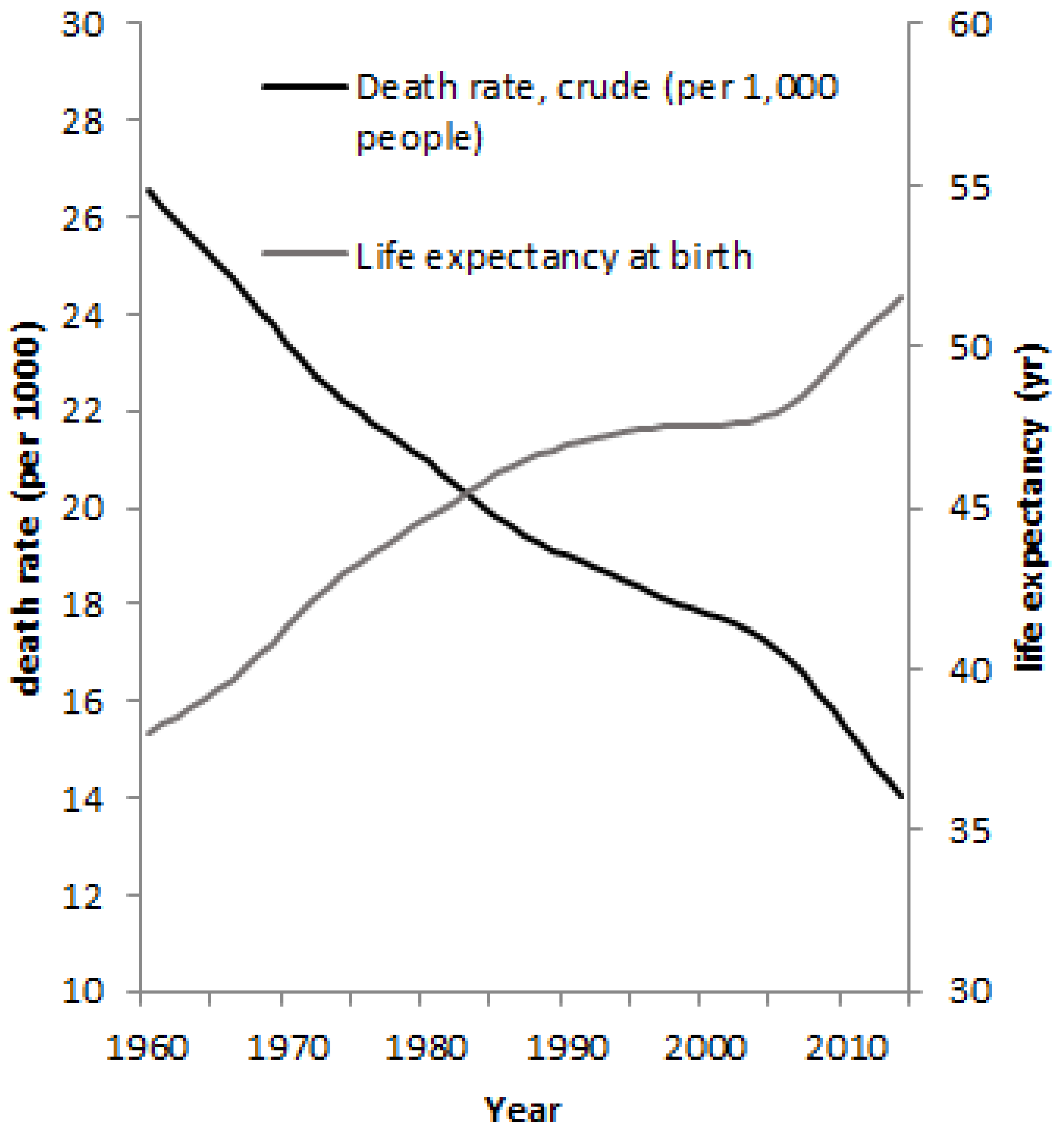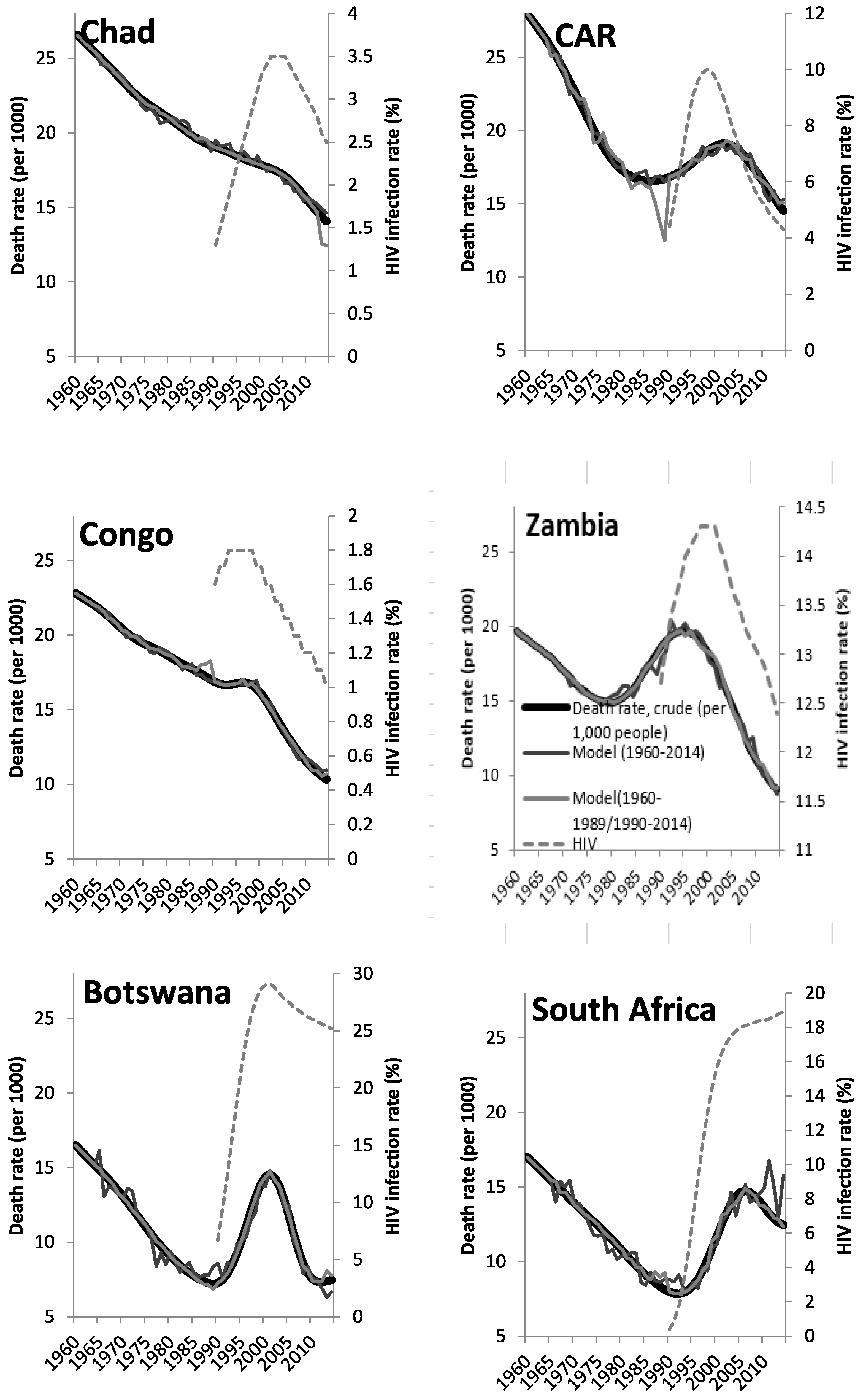The Dominance of Food Supply in Changing Demographic Factors across Africa: A Model Using a Systems Identification Approach
Abstract
:1. Introduction
1.1. Theoretical Background
1.2. Approach of This Work
2. Data, and Explanatory and Response Variables
3. Methodology
3.1. The NARMAX Method
3.2. The Polynomial NARMAX Model
3.3. Models Linking the Environment, Society and Demography
4. Results
4.1. Explanatory Data
4.2. The Identified Nonlinear Models
5. Discussion
5.1. N-S Transect
5.2. W-E Transects
5.3. Similarities and Contrasts between Transects
6. Conclusions
Supplementary Materials
Acknowledgments
Author Contribution
Conflicts of Interest
References
- Akanyeti, Otar, Ulrich Nehmzow, and Steve A. Billings. 2008. Robot training using system identification. Robotics and Autonomous Systems 56: 1027–41. [Google Scholar] [CrossRef]
- Allouche, Jeremy. 2011. The sustainability and resilience of global water and food systems: Political analysis of the interplay between security, resource scarcity, political systems and global trade. Food Policy 36: S3–8. [Google Scholar] [CrossRef]
- Balikhin, Michael A., Richard J. Boynton, Simon N. Walker, J. E. Borovsky, Steve A. Billings, and Hua-liang Wei. 2011. Using the NARMAX approach to model the evolution of energetic electrons fluxes at geostationary orbit. Geophysical Research Letters 38: L18105. [Google Scholar] [CrossRef]
- Bernauer, Thomas, Tobias Böhmelt, and Valli Koubi. 2012. Environmental changes and violent conflict. Environmental Research Letters, 7. [Google Scholar] [CrossRef] [Green Version]
- Bigg, Grant R., Hua-Liang Wei, David J. Wilton, Yifan Zhao, Steve A. Billings, Edward Hanna, and Visakan Kadirkamanathan. 2014. A century of variation in the dependence of Greenland iceberg calving on ice sheet surface mass balance and regional climate change. Proceedings of the Royal Society Series A 470. [Google Scholar] [CrossRef] [PubMed]
- Billings, Steve A. 2013. Non-Linear System Identification: NARMAX Methods in the Time, Frequency, and Spatio-Temporal Domains. London: Wiley. [Google Scholar]
- Billings, Catherine G., Hua-Liang Wei, Patrick Thomas, S. J. Linnane, and B. D. M. HopeGill. 2013. The prediction of in-flight hypoxaemia using non-linear equations. Respiratory Medicine 107: 841–847. [Google Scholar] [CrossRef] [PubMed]
- Billings, Steve A., and Hua-Liang Wei. 2005. The wavelet-NARMAX representation: A hybrid model structure combining polynomial models with multiresolution wavelet decompositions. International Journal of Systems Science 36: 137–52. [Google Scholar] [CrossRef]
- Blouin, Max, and Stephane Pallage. 2016. Warlords, famine and food aid: Who fights, who starves? European Journal of Political Economy 45: 18–38. [Google Scholar] [CrossRef]
- Buhaug, Halvard. 2010. Climate not to blame for African civil wars. Proceedings of the National Academy of Sciences USA 107: 16477–82. [Google Scholar] [CrossRef] [PubMed]
- Burkart, Katrin, Mohammed Mobarrak Hossain Khan, Alexandra Schneider, Susanne Breitner, Marcel Langner, Alexander Kraemer, and Wilfried Endlicher. 2014. The effect of season and meteorology on human mortality in tropical climates: A systematic review. Transactions of the Royal Society of Tropical Medicine and Hygiene 108: 393–401. [Google Scholar] [CrossRef] [PubMed]
- Burke, Marshall B., Edward Miguel, Shanker Satyanath, John A. Dykema, and David B. Lobell. 2009. Warming increases the risk of civil war in Africa. Proceedings of the National Academy of Sciences USA 106: 20670–74. [Google Scholar] [CrossRef] [PubMed]
- Butler, Colin D. 2014. Famine, hunger, society and climate change. In Climate Change and Global Health. Edited by Colin D. Butler. Oxford: Centre for Agriculture and Biosciences International, pp. 124–34. [Google Scholar]
- Canning, David. 2011. The causes and consequences of demographic transition. Population Studies 65: 353–61. [Google Scholar] [CrossRef] [PubMed]
- Chen, Sheng, and Steve A. Billings. 1989. Representation of non-linear systems: The NARMAX model. International Journal of Control 49: 1013–32. [Google Scholar] [CrossRef]
- Chen, Sheng, Steve A. Billings, Colin F. N. Cowan, and Peter M. Grant. 1990. Practical identification of NARMAX models using radial basis functions. International Journal of Control 52: 1327–50. [Google Scholar] [CrossRef]
- Chiras, Neopbytos, Ceri Evans, and David Rees. 2001. Nonlinear gas turbine modeling using NARMAX structures. IEEE Transactions on Instrumentation and Measurement 50: 893–98. [Google Scholar] [CrossRef]
- De Walque, Damien, and Deon Filmer. 2013. Trends and socioeconomic gradients in adult mortality around the developing world. Population and Development Review 39: 1–29. [Google Scholar] [CrossRef]
- Dong, Weihua, Zhao Liu, Hua Liao, Qiuhong Tang, and Xian’en Li. 2015. New climate and socio-economic scenarios for assessing global human health challenges due to heat risk. Climate Change 130: 505–18. [Google Scholar] [CrossRef]
- Eastwood, Robert, and Michael Lipton. 2011. Demographic transition in sub-Saharan Africa: How big will the economic divide be? Population Studies 65: 9–35. [Google Scholar] [CrossRef] [PubMed]
- Evenson, Robert E., and Douglas Gollin. 2003. Assessing the impact of the Green Revolution, 1960–2000. Science 300: 758–62. [Google Scholar] [CrossRef] [PubMed]
- Hartmann, Dennis L., Albert M. G. Klein Tank, Matilde Rusticucci, Lisa V. Alexander, Stefan Brömmimann, Yassine Charabi, Frank J. Dentener, Edward J. Dlugokencky, David R. Easterling, Alexey Kaplan, and et al. 2013. Observations: atmosphere and surface. In Climate Change 2013: The Physical Science Basis. Edited by Thomas F. Stocker, Dahe Qin, Gian-Kasper Plattner, Melinda M.B. Tigonor, Simon K. Allen, Judith Boschung, Alexander Nauels, Yu Xia, Vincent Bex and Pauline M. Midgley. Cambridge: Cambridge University Press, pp. 159–254. [Google Scholar]
- Jeuland, Marc A., David E. Fuente, Semra Ozdemir, Maura C. Allaire, and Dale Whittington. 2013. The long-term dynamics of mortality benefits from improved water and sanitation in less developed countries. PLoS ONE 8: e74804. [Google Scholar] [CrossRef] [PubMed]
- Lacina, Bethany, and Nils P. Gleditsch. 2005. Monitoring trends in global combat: A new dataset of battle deaths. European Journal of Population 21: 145–66. [Google Scholar] [CrossRef]
- Leontaritis, I. J., and Steve A. Billings. 1985a. Input–output parametric models for non-linear systems—Part I: Deterministic non-linear systems. International Journal of Control 41: 303–28. [Google Scholar] [CrossRef]
- Leontaritis, I. J., and Steve A. Billings. 1985b. Input–output parametric models for non-linear systems—Part II: Stochastic non-linear systems. International Journal of Control 41: 329–44. [Google Scholar] [CrossRef]
- Lindskog, Elina Elveborg. 2016. The effect of war on infant mortality in the Democratic Republic of Congo. BMC Public Health 16: 1059. [Google Scholar] [CrossRef] [PubMed]
- Loevinsohn, Michael. 2015. The 2001–03 famine and the dynamics of HIV in Malawi: A natural experiment. PLoS ONE 10: e0135108. [Google Scholar] [CrossRef] [PubMed]
- Marshall, Abigail M., Grant R. Bigg, Sonja M. van Leeuwen, John K. Pinnegar, Hua-Liang Wei, Thomas J. Webb, and Julia L. Blanchard. 2016. Quantifying heterogeneous responses of fish community size structure using novel combined statistical techniques. Global Change Biology 22: 1755–68. [Google Scholar] [CrossRef] [PubMed]
- Mathers, Colin D., Ties Boerma, and Doris Ma Fat. 2009. Global and regional causes of death. British Medical Bulletin 92: 7–32. [Google Scholar] [CrossRef] [PubMed]
- Morgan, Dilys, Gillian H. Maude, Samuel S. Malamba, Martin J. Okongo, Hans-Ulrich Wagner, Daan W. Mulder, and James A. Whitworth. 1997. HIV-1 disease progression and AIDS-defining disorders in rural Uganda. Lancet 350: 245–50. [Google Scholar] [CrossRef]
- Morgan, Dilys, Cedric Mahe, Billy Mayanja, Martin J. Okongo, Rosemary Lubega, and James A. G. Whitworth. 2002. HIV-1 infection in rural Africa: is there a difference in median time to AIDS and survival with that in industrialized countries? AIDS 16: 597–603. [Google Scholar] [CrossRef] [PubMed]
- Nelles, Oliver. 2001. Nonlinear System Identification. Berlin: Springer. [Google Scholar]
- Nicholson, Sharon E. 2001. Climatic and environmental change in Africa during the last two centuries. Climate Research 17: 123–44. [Google Scholar] [CrossRef]
- OECD. 2013. Life Expectancy at Birth, in Health at a Glance 2013 OECD Indicators. Paris: OECD Publishing, Available online: http://dx.doi.org/10.1787/health_glance-2013-5-en (accessed on 13 October 2017).
- Salam, Asharaf Abdul, Ibrahim Elsegaey, Rshood Khraif, Abdullah AlMutairi, and Ali Aldosari. 2015. Components and public health impact of population growth in the Arab World. PLoS ONE 10: e0124944. [Google Scholar] [CrossRef] [PubMed]
- Sarrigiannis, Ptolemaios G., Yifan Zhao, Hua-Liang Wei, Steve A. Billings, Jayne Fotheringham, and Marios Hadjivassiliou. 2014. Quantitative EEG analysis using error reduction ratio-causality test: Validation on simulated and real EEG data. Clinical Neurophysiology 125: 32–46. [Google Scholar] [CrossRef] [PubMed]
- Schönfeldt, Hettie C., and Nicolette G. Hall. 2012. Dietary protein quality and malnutrition in Africa. British Journal of Nutrition 108: S69–76. [Google Scholar] [CrossRef] [PubMed]
- Sen, Amartya. 2008. Violence, identity and poverty. Journal of Peace Research 45: 5–15. [Google Scholar] [CrossRef]
- Song, Zhuoyi, Marten Postma, Steve A. Billings, Daniel Coca, Roger C. Hardie, and Mikko Juusola. 2012. Stochastic, Adaptive Sampling of Information by Microvilli in Fly Photoreceptors. Current Biology 22: 1371–80. [Google Scholar] [CrossRef] [PubMed]
- Theisen, Ole M., Nils P. Gleditsch, and Halvard Buhaug. 2013. Is climate change a driver of armed conflict? Climatic Change 117: 613–25. [Google Scholar] [CrossRef]
- Wandiga, Shem O., Maggie Opondo, Daniel Olago, Andrew Githeko, Faith Githui, Michael Marshall, Tim Downs, Alfred Opere, Christopher Oludhe, Gilbert O. Ouma, and et al. 2010. Vulnerability to epidemic malaria in the highlands of Lake Victoria basin: The role of climate change/variability, hydrology and socio-economic factors. Climatic Change 99: 473–97. [Google Scholar] [CrossRef]
- Wei, Hua-Liang, and Steve A. Billings. 2008. Model structure selection using an integrated forward orthogonal search algorithm assisted by squared correlation and mutual information, International Journal of Modelling. Identification and Control 3: 341–56. [Google Scholar]
- Wei, Hua-Liang, Steve A. Billings, and Michael Balikhin. 2004a. Prediction of the Dst index using multiresolution wavelet models. Journal of Geophysical Research—Atmospheres 109: A07212. [Google Scholar] [CrossRef]
- Wei, Hua-Liang, Steve A. Billings, and Jianhua Liu. 2004b. Term and variable selection for nonlinear system identification. International Journal of Control 77: 86–110. [Google Scholar] [CrossRef]
- Wei, Hua-Liang, Steve A. Billings, and Michael A. Balikhin. 2006. Wavelet based non-parametric NARX models for nonlinear input-output system identification. International Journal of Systems Science 37: 1089–96. [Google Scholar] [CrossRef]
- Wei, Hua-Liang, Ding-Qiu Zhu, Steve A. Billings, and Michael A. Balikhin. 2007. Forecasting the geomagnetic activity of the Dst index using multiscale radial basis function networks. Advances in Space Research 40: 1863–70. [Google Scholar] [CrossRef]
- Wei, Hua-Liang, Steve A. Billings, Yifan Zhao, and Lingzhong Guo. 2010. An adaptive wavelet neural network for spatio-temporal system identification. Neural Networks 23: 1286–99. [Google Scholar] [CrossRef] [PubMed]
- Yaduma, Natina, Mika Kortelainen, and Ada Wossink. 2013. Estimating mortality and economic costs of particulate air pollution in developing countries: The case of Nigeria. Environmental & Resource Economics 54: 361–87. [Google Scholar]
- Zaman, Khalid, Aqeel Ahmad, Tengku Adeline Adura Tengku Hamzah, and Mariney Mohd Yusoff. 2016. Environmental factors affecting health indicators in sub-Saharan African countries: Health is wealth. Social Indicators Research 129: 215–28. [Google Scholar] [CrossRef]
- Zhang, David D., Peter Brecke, Harry F. Lee, Yuan-Qing He, and Jane Zhang. 2007. Global climate change, war, and population decline in recent human history. Proceedings of the National Academy of Sciences USA 104: 19214–19. [Google Scholar] [CrossRef] [PubMed]
- Zhao, Yifan, Steve A. Billings, Hua-Liang Wei, and Ptolemaios G. Sarrigiannis. 2012. Tracking time varying causality and directionality of information flow using an error reduction test with applications to electroencephalography data. Physics Review E 86: 1–11. [Google Scholar] [CrossRef] [PubMed]
- Zhao, Yifan, Grant R. Bigg, Stephen A. Billings, Edward Hanna, Andrew J. Sole, Hua-Liang Wei, Visakan Kadirkamanathan, and David J. Wilton. 2016. Inferring the variation of climatic and glaciological contributions to West Greenland iceberg discharge in the twentieth century. Cold Regions Science and Technology 121: 167–78. [Google Scholar] [CrossRef]




| Variable | Description |
|---|---|
| u1 (explanatory)1 | Agricultural production index (1999–2001 = 100) |
| u2 (explanatory)2 | Average precipitation (mm·yr−1) |
| u3 (explanatory)3 | GDP per capita (constant 2000 US$) |
| u4 (explanatory)4 | Population growth (annual %) |
| u5 (explanatory)5 | Food/person index |
| u6 (explanatory)2 | Average annual air temperature anomaly (°C) |
| u7 (explanatory)5 | Water per capita |
| u8 (explanatory)3 | Land under cereal production (hectares relative to 1961) |
| u9 (explanatory)3 | Livestock production index (2005–2006 = 100) |
| u10 (explanatory)3 | HIV infection rate (from 1990; % population aged 15–49) |
| y1 (response)3 | Death rate, crude (per 1000 people) |
| y2 (response)3 | Life expectancy at birth (years) |
| Country | Latitude Band | Longitude Band |
|---|---|---|
| Libya | 20–33° N | 10–25° E |
| Chad | 8.5–24° N | 13–24° E |
| Central African Republic | 3–10° N | 15–27° E |
| Democratic Republic of Congo | 12° S–5° N | 13–30° E |
| Zambia | 9–18° S | 22–33° E |
| Botswana | 18–26° S | 20–29° E |
| South Africa | 22–34° S | 17–33° E |
| Mauritania | 16–26° N | 16–6° W |
| Mali | 10–24° N | 12° W–4° E |
| Niger | 13–23° N | 0–15° E |
| Sudan | 10–22° N | 24–38° E |
© 2017 by the authors. Licensee MDPI, Basel, Switzerland. This article is an open access article distributed under the terms and conditions of the Creative Commons Attribution (CC BY) license (http://creativecommons.org/licenses/by/4.0/).
Share and Cite
Wei, H.; Bigg, G.R. The Dominance of Food Supply in Changing Demographic Factors across Africa: A Model Using a Systems Identification Approach. Soc. Sci. 2017, 6, 122. https://doi.org/10.3390/socsci6040122
Wei H, Bigg GR. The Dominance of Food Supply in Changing Demographic Factors across Africa: A Model Using a Systems Identification Approach. Social Sciences. 2017; 6(4):122. https://doi.org/10.3390/socsci6040122
Chicago/Turabian StyleWei, Hualiang, and Grant R. Bigg. 2017. "The Dominance of Food Supply in Changing Demographic Factors across Africa: A Model Using a Systems Identification Approach" Social Sciences 6, no. 4: 122. https://doi.org/10.3390/socsci6040122





